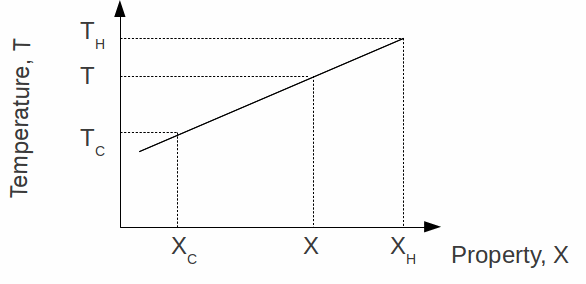The temperature of a body is a measure of how hot or cold it is. If two bodies are placed in thermal contact then heat will be transferred from the hotter to the colder until both are at the same temperature. When they are at the same temperature they are said to be in thermal equilibrium. Heat is not a substance – it does not weigh anything. You can not see or touch it, though you may feel the heat of an object at a distance because of the energy it radiates, or because when you touch it it is either hot or cold.
There are many possible scales of temperature that can be used. To obtain a temperature scale we must choose to measure a property of a material that varies with temperature and choose two 'fixed points' called![]() and
and![]() taken at cold and hot temperature respectively, defined by some property of the material.
taken at cold and hot temperature respectively, defined by some property of the material.
The value of the property,![]() is measured at both ends, and the temperature at any intermediate point is found by assuming the property in question varies linearly with temperature.
is measured at both ends, and the temperature at any intermediate point is found by assuming the property in question varies linearly with temperature.

Hence given any value of this property, the temperature can be found from the equation,
![]()
For example, we could choose to measure the length of a metal bar. As the temperature increases, so does the length of the bar. The relationship between length and temperature is approximately linear, given by![]() more commonly written in the form
more commonly written in the form![]() where
where![]() is the coefficient of linear expansion and
is the coefficient of linear expansion and![]() is the temperature relative to 0 degrees Celsius.
is the temperature relative to 0 degrees Celsius.
